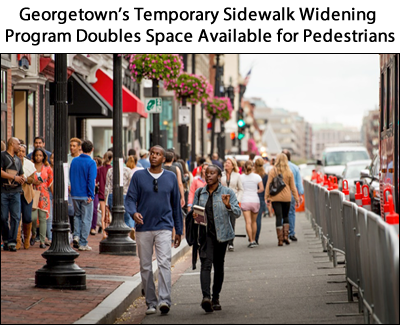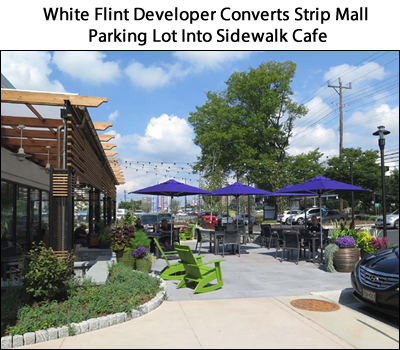Sometimes a few small changes can transform an uninviting, vehicle-dominated city street or intersection into a space where pedestrians feel safe and welcome, encouraging more travel by foot and a more vibrant street scene.
In a recent half-day workshop organized by the Transportation Planning Board, more than 60 local transportation planners and pedestrian advocates from around the Washington region gathered to learn about and discuss ways to create more pedestrian-friendly spaces.
One of the main features of the workshop was a presentation by one of the co-directors of New York City's Pedestrian Projects Group, which has reconfigured dozens of the city's streets and intersections to give pedestrians more sidewalk space, to help them cross streets more safely, and to create a more inviting setting through the addition of lighting, seating, and vegetation.
More: See before-and-after photos from the NYC Pedestrian Projects Group
The workshop also highlighted more than a dozen examples and case studies throughout the Washington region. One was a relatively recent effort by the Georgetown Business Improvement District (BID) to temporarily widen sidewalks along M Street and Wisconsin Avenue on busy weekend days.
|

Georgetown BID/Sam Kitner Photography
|
According to the Georgetown BID representative who presented at the workshop, approximately 58,000 pedestrian trips were recorded along M Street on one recent Saturday, about twice the number of roadway-based vehicle trips recorded on the same day. On such busy days, the BID has started using temporary metal barricades to block off parking lanes adjacent to sidewalks to essentially double the width of the space available to pedestrians.
More: Photos and data from the Georgetown BID's Temporary Weekend Sidewalk Widening program
Planners and engineers elsewhere in the District have also undertaken efforts to "right-size" sidewalks, either by narrowing those that are too wide, or by widening those that are two narrow. In the Farragut Square area and NoMa neighborhood, officials have broken up wide sidewalks with rain gardens, planters, and street furniture, while in Adams Morgan and Brookland, the city has removed unnecessary parking and travel lanes and permanently replaced them with wider sidewalks or pedestrian plazas.
Pedestrian plazas are also under consideration in the City of Alexandria -- on a half-block segment of King Street near the waterfront in Old Town, and on a small parcel of unused land along Mount Vernon Avenue in Del Ray. In both places, planners want to expand existing sidewalks to build small plazas with tables, chairs, and planters to encourage use by those on foot.
|

Federal Realty
|
And pedestrian space-making efforts are underway in more suburban parts of the region, too. Near the White Flint Metro station in Montgomery County, a developer with plans to transform existing strip-mall development and large parking lots into an urban, mixed-use neighborhood also sees retrofitting the local transportation network to attract more users on foot. The developer, who shared his plans at the recent workshop, envisions a more interconnected street grid, more frequent signal-protected crossings of nearby thoroughfares, providing space for more outdoor cafes and parks, and narrowing travel lanes in certain places to slow traffic to safer speeds.
More: Presentations from the April 28 workshop
All of the pedestrian space-making efforts highlighted at the recent work workshop help support regional transportation goals to increase travel by walking and biking, to strengthen Activity Centers by improving local circulation, and to improve traffic safety. They also help beautify the built environment and enhance overall quality of life.
The recent workshop was organized by the TPB's Bicycle and Pedestrian Subcommittee. It complements two other TPB workshops held in recent years -- one focused on designing "Complete Streets" that accommodate users of all travel modes, and the other focused on implementing "Green Streets" treatments that help reduce stormwater runoff from pavement and sidewalks.
Related: Survey Finds Number of Local "Complete Streets" Policies in the Region Growing
Related: Regional "Green Streets" Policy Encourages Efforts to Limit Impacts of Stormwater Runoff
Related Links